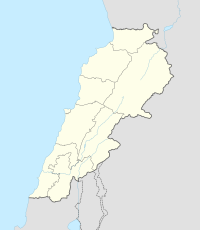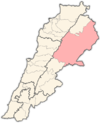Yammoune
Yammoune
Yammouneh, El Yammoûné | |
|---|---|
Village | |
 The Naba al-Arbain spring of Yammoune | |
| Country | |
| Governorate | Baalbek-Hermel |
| District | Baalbek |
| Elevation | 5,300 ft (1,600 m) |
| Population (2021) | |
| • Total | 7,000 of the Chreif family عشيرة آل شريف |
 | |
| Location | 25 kilometres (16 mi) northwest of Baalbek |
|---|---|
| Region | Baalbek |
| Coordinates | 34°08′00″N 36°01′00″E / 34.133333°N 36.016667°E |
| History | |
| Cultures | Roman, Ancient Greece, Phoenicia |
| Site notes | |
| Condition | Ruins |
| Public access | Yes |
Yammoune is a lake, nature reserve, village and municipality situated 27 kilometres (17 mi) northwest of Baalbek in Baalbek District, Baalbek-Hermel Governorate, Lebanon. The village has a few hundred inhabitants.[1][2]
Ancient Roman temple
There are the ruins of a Roman temple (possibly with phoenician-greek origins) in the village that are included in a grouping of Roman Temples of the Beqaa Valley. It is said to be dedicated to Venus[3] (or possibly also Astarte, before the Roman era in the region). Part of two enclosure walls and the temple foundations remain intact.[1] Many inscriptions, written in Latin were found at the temple site.[4] A few Ancient Greek inscriptions were also found.[5] It is considered likely to be initially very small and of Phoenician origin, but it was greatly enlarged and improved by the Romans[6]
- All that remains of the Roman temple today is a retaining wall of limestone blocks which goes down to the lake level. Beneath are supposed to be subterranean chambers. Presumably dedicated to Venus-Astrate, legend has it that when Typhon made war against the heavens, it was at Yammouneh that Venus changed herself into a fish...A great water cavern west of the temple fills the lake each year, although at other times it may appear almost dry. Luxurious Roman villas used to occupy the area between the cavern and the temple and numerous altars, statues and other elements have been discovered nearby. [7]
The temple is situated on a hill, approximately 300 metres (980 ft) from the main
Alouf also found a
Eusebius records that the Emperor Constantine destroyed a temple of Venus 'on the summit of Mount Lebanon.'[11] and probably it was this pagan temple dedicated to Venus.
During the 1970s Ali Akbar Mohtashamipur lived in Yammoune whilst receiving military training at a Fatah camp. He later held a number of senior posts in the Iranian government. He wrote about the village “Their men are courageous and mostly armed ... They don’t submit to government authority and don’t pay for water and electricity. They have fought several times with neighbouring Christian villages and have won. They like the [Shiite] clergy.”[12]
Geology
The village lies on the Yammoune Fault line, a geological fault responsible for several historical earthquakes in the area. A new section of the fault was discovered in 2010 by Ata Elias of the American University of Beirut. They studied samples from a trench in Marjahine that will allow them to improve dating on historical earthquakes and better predict future ones.[13]
Lake Yammoune
Lake Yammoune is home to Lebanon's only endemic fish, Pseudophoxinus libani.[14] In Phoenician Mythology, the goddess Astarte turned herself into a golden fish in Yammoune lake to escape from the vengeance of Adonis's wrathful brother Typhon.[1]
The lake is filled from a water cavern to the west of the temple has only one outflow, through a big hole and Robert Boulanger suggested that it might dry up entirely at the end of summer.[1] The valley of Ouyoun Ergush leads from Yammoune towards Marjhine.[15]
A network of rock-cut irrigation channels and watercourses lead from Lake Yammoune to provide irrigation for the region of the Beqaa Valley around Baalbek.[16]
Possible early sanctuary of El
Marvin H. Pope (Yale University) identified the home of
Yammoune nature reserve
The area has been classed as a scientific and cultural
References
- ^ a b c d Robert Boulanger (1955). Lebanon. Hachette. Retrieved 30 October 2012.
- ^ a b c Nashrat al-Āthār wa-al-ʻImārah al-Lubnānīyah. Direction Générale des Antiquités. 2008. Retrieved 30 October 2012.
- ^ George Taylor (1971). The Roman temples of Lebanon: a pictorial guide. Les temples romains au Liban; guide illustré. Dar el-Machreq Publishers. Retrieved 30 October 2012.
- ISBN 978-0-89236-715-3. Retrieved 30 October 2012.
- ^ Marcus Niebuhr Tod (1979). The Progress of Greek Epigraphy: The progress of Greek epigraphy, 1937–1953. Ares. Retrieved 30 October 2012.
- ^ ISBN 978-2-7469-3699-7. Retrieved 30 October 2012.
- ^ Robert Boulanger
- ISBN 978-1-4464-8366-4. Retrieved 30 October 2012.
- ISBN 978-0-89236-715-3. Retrieved 30 October 2012.
- ISBN 978-1-58509-063-1. Retrieved 30 October 2012.
- ^ Eusebius 'Life of Constantine' III.54
- ISBN 978-0-571-23741-8p.177
- ^ Study uncovers new segment of Yammouneh fault line, The Daily Star (Lebanon), 3 November, 2010.
- ^ Jaradi, Ghassan Ramasdan., State & Trends of the Lebanese Environment, Chapter 5, Biodiversity and Forests, United Nations Development Programme for the Lebanese Ministry of the Environment, p. 157, 2010.
- ISBN 978-2-903188-20-7. Retrieved 30 October 2012.
- ^ James Stevens Simmons; Tom French Whayne; Gaylord West Anderson; Harold Maclachlan Horack; United States Surgeon-General's Office: Preventive Medicine Service (1944). Global epidemiology: a geography of disease and sanitation. J.B. Lippincott company. Retrieved 30 October 2012.
- ^ ARI, p. 72.
- W. F. Albright, in Journal of Biblical Literature 75.3 (September 1956:255-257), who remarked, "However, the identification of El's home with a place in Phoeniciadoesnot mean that it was not also at a great distance in a cosmic 'never never land'". The "cultic geography" of Adonis, including Afqa, is inspected by Brigitte Soyez in the opening section of Byblos et les fêtes des Adonies (Leiden: Brill) 1977.
- ^ DHIAFEE Program, Suggested tours.
External links
- Yammoune.net
- Yammouneh, Localiban
- yammouneh.blogspot.co.uk
- Aerial view of fields near Yammoune on discoverlebanon.com
- Yammoune on discoverlebanon.com
- Panoramic view of Lake Yammoune on discoverlebanon.com
- Yammouneh Cultural Club Facebook page
- Yammouneh nature reserve on lebanonatlas.com
- Photo of Yammoune on the website of the American University of Beirut
- Photo of Yammoune watercourse on the website of the American University of Beirut
- Photo of Yammoune temple on the website of the American University of Beirut
- Photo of Yammoune temple on the website of the American University of Beirut
- Photo of Yammoune temple on the website of the American University of Beirut
- Yammouneh on wikimapia.org
- Yammouneh municipality on wikimapia.org



